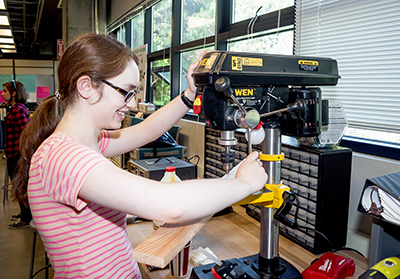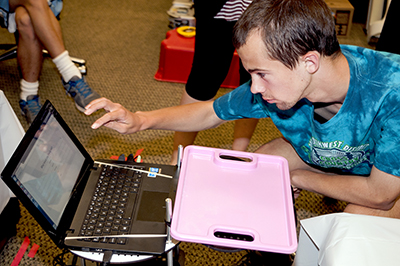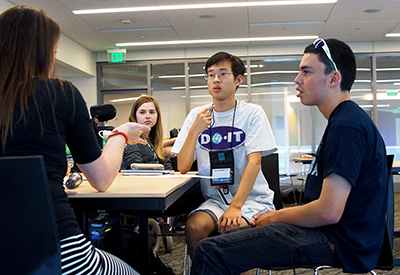Summer Study: What Do Phase II Scholars Do?
Phase II Scholars return to the UW Seattle campus for their second Summer Study. They meet the Phase I Scholars, learn about college life and career preparation, and participate in a one-week workshop with postsecondary instructors.
Reel Grrls (and Guys, too!)
This year, five of the Phase II Scholars took part in producing their own short videos. In collaboration with Seattle-based Reel Grrls, an organization mainly for girls to feel empowered and discover their potential through media production, our students planned their own stories, learned film techniques, investigated how disability is portrayed in the media, and edit video footage.
We started our workshop with a presentation on the Disability Rights Movement. The purpose of this presentation was to give us a background on the negative stereotypes associated with of people with disabilities, along with the medical and social models of disability. We also watched videos related to disability rights, such as comedian Stella Young’s TED Talk on people with disabilities as objects of inspiration, an episode of a video series called, “My Gimpy Life,” and various notable clips featuring people with disabilities in movies.
At the same time, we developed basic abilities to record and edit videos through mobile devices, including the iPod Touch and the iPad. We learned the different types of shots, such as wide-shot, medium shot, and close-up. The purpose of these videos was to convey a message regarding a stance on disability and an issue, guided by the creator’s story.
Visiting the CoMotion MakerSpace

Need a place to build, as well as get inspired and find your creativity? The CoMotion MakerSpace is the right place for you. The CoMotion MakerSpace at the University of Washington (UW) is a place built for UW students and the UW community to freely express their ideas and collaborate to create projects together. As DO-IT Interns, we were invited to go and experience the opportunities at the makerspace.
On the first day, we made a prototype of our ideal wallet. We worked in groups to sketch a design, and we interviewed each other on how an ideal wallet would look and function. The challenge to the activity was a 10-minute time limit and a limited amount of materials; we could only use cardboard, straws, paper clips, tapes, sticky notes and blank papers.
After the challenge, we discussed how we could make current and future makerspaces more accessible to people with disabilities. We brainstormed positive and negative aspects about the accessibility of this makerspace. One positive was that most tables and whiteboards in the workstation area used wheels, which make it easier for wheelchair users to move around in the large space. On the other hand, one of the problems was that some of the tools provided for students may not be accessible for students with disabilities, especially wheelchair users. There were also no large prints or braille signs to help people who have a visual impairment. As a group, we came up with ideas of what kind of improvements the CoMotion MakerSpace needs to improve its accessibility.
We are really excited and looking forward to see the improvements we came up with to improve accessibility for future makerspaces so both able-bodied and people with disabilities can collaborate.
[Note: A checklist for making an accessible makerspace can be found on the DO-IT website.]
Robotics

The picture most people have of a robot comes from science fiction movies. Robots are generally seen as futuristic entities that can gain self-awareness at any time. In general, robots are programmed to perform certain tasks, have partial autonomy, and have at least two degrees of freedom. A microwave oven or a cell phone could arguably be considered simple robots.
Maya and Sarah ran the robotics workshop. We worked with robots named Chester, a TurtleBot, and Rosie, a PR2. Rosie was large, had arms that moved in many directions, and numerous cameras with varying ranges. Chester was much smaller, did not have arms, and used an Xbox Kinect as a camera. The Scholars discussed ideas for a scenario to conduct using the robots, deciding on a restaurant scene. Chester was the waiter and Rosie was the chef. Chester was programmed with the programming language Python. We programmed it to greet and seat the guests, take orders, deliver food, and collect payment.
Everyone learned something, even the Interns. Mike and Kennedy were proud to say that they learned just as much from their programming failures as they did from their programming successes. Vanessa enjoyed the experience of working with real-life robots. Jason liked the challenge of programming, and Sangha enjoyed coming up with real-world applications for the robots. The greatest takeaways were lessons in teamwork, programming, and real-world applications of robotics. We greatly appreciate all the time and effort the workshop leaders put into making this experience possible.
Exploratory Neurobiology
Martha Bosma studies the spontaneous calcium activity in embryonic mouse and chick brain stems, analyzing spontaneous electrical activity in nervous system development. While the lab was fairly accessible, two Phase I Scholars had difficulty accessing high-placed equipment and fitting through the narrow aisles. These issues could be solved with small adjustments in the lab.
The Scholars experimented with mice embryos and cockroaches. They saw how nicotine and other drugs affected the mouse’s heart reactions and the cockroach’s leg and spine movements. Scholars learned how to identify axon potentials and to graph patterns for calcium channel reactions. By the end of the workshop, Scholars learned the inner workings of neurons in real time.
Summer Study Highlights

It was truly a privilege and an honor to serve as a DO-IT Intern at Summer Study this past July. Having gone through the program in previous years as a Phase I and Phase II Scholar, I gained invaluable skills and support that have been vital to my success as a student and as a person. I jumped at the opportunity to pass down my newly-acquired knowledge to the new Scholars. We participated in countless activities throughout the 10-day experience; here are a few highlights:
- Scholar/Intern panel—I enjoyed being able to answer the Scholars’ questions and provide them with advice with regard to navigating college life with a disability.
- Visits to the Pacific Science Center and Woodland Park Zoo—It was fun seeing the exhibits and hanging out with everyone.
- Resume workshops/mock interviews—Having gone through the employment process, I was able to share with the Scholars my experiences, simulate real-world situations and offer them tips on how to “sell themselves” to employers.
Overall, Summer Study was an outstanding success. I sincerely hope everyone involved (Scholars, Interns, and Staff) uses this experience to grow and pave new paths for themselves. I will continue to do my part to improve myself and strengthen the connections within the DO-IT family.